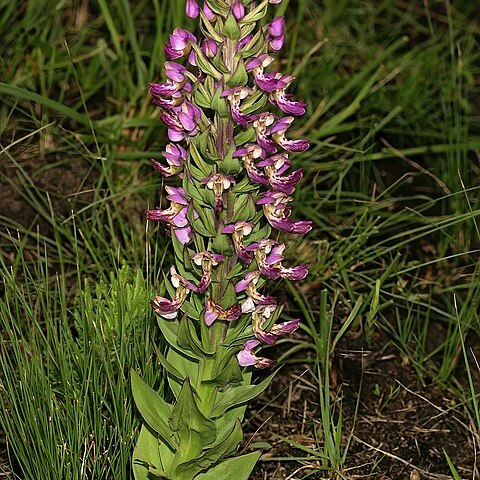Plants erect, to 400 mm, robust to slender; leaves cauline, closely imbricate, lanceolate to broadly lanceolate, acute to acuminate, stiff, glabrous, to 70 x 25 mm. Inflorescences subdense to dense spikes, to 270 mm; bracts to 30 x 8 mm. Flowers 20-100, rather fleshy in texture, c. 20 x 10 mm, sepals pink to pale mauve, petals the same colour but paler, lip keel white with irregular purple spots; ovaries to 20 mm long. Median sepal erect, shallowly concave, lanceolate, acute, 5-6 x 3-4 mm; lateral sepals oblique, shallowly concave, subacute, 7-8 x 3-4 mm. Petals fused basally to the gynostemium, obliquely ovate or elliptic-ovate, closely placed on each side of the gynostemium, obtuse, 6-7 x 3-5 mm. Lip spathulate, 8-16 mm long; limb scaphoid; blade c. 6 x 4 mm, strongly keeled, convex, usually trilobed with the midlobe exceeding, equalling or shorter than the side lobes; spur absent. Gynostemium c. 3 mm tall, erect; stigma pad-like with reduced midlobe; rostellum c. 1 mm tall, 3-lobed, lateral lobes bearing the viscidia, central lobe reduced.
Terrestrial herb, geophyte, erect, robust, 0.28-0.40 m high; roots tuberous. Leaves cauline, many, lanceolate, up to 70 x 22 mm, imbricate, gradually decreasing in density and size upwards. Inflorescence a dense raceme. Flowers pale white with shades of pink to pale mauve, central white keel, purple spots on lip. Sepals free; dorsal sepal 5-7 mm long; lateral sepals ascending or spreading, recurved. Petals oblique, similar to dorsal sepal. Lip 10-13 mm long, 3-lobed at apex, margins deflexed; spur absent. Flowering time Oct.-Jan.
Lip 11.5–14.5 mm long; hypochile boat-shaped 3.5–6 mm long; epichile 8.5–10.5 × 6.5–10.5 mm, broadly obovate, 3-lobed near the apex or in the upper part, with a central ridge running into the mid-lobe; the side lobes reflexed.
Terrestrial herb, up to 400 mm tall. Leaves numerous, lanceolate, up to 70 x 22 mm. Lip 3-lobed at apex, central keel white with purple spots. Flowers pink to pale mauve.
Inflorescence 13–25 × 4–6 cm, fairly laxly to densely many-flowered; ovary and pedicel 1.5–1.6 cm long; bracts up to 4 cm long.
Petals 6–10 × 2.8–7 mm, obliquely oblong or ovate with a rounded auricle in front, standing forwards beside the column.
Leaves numerous, overlapping, up to 7 × 2.5 cm, lanceolate or ovate, acute or acuminate.
Terrestrial herb 25–55 cm tall with woolly, cylindrical roots.
Dorsal sepal 6.8–7.5 × 3–4.2 mm, elliptic or ovate, convex.
Lateral sepals 7–9.3 × 2–4.7 mm, obliquely ovate.
Column stout, 3–4 mm long.
Flowers mauve and white.

